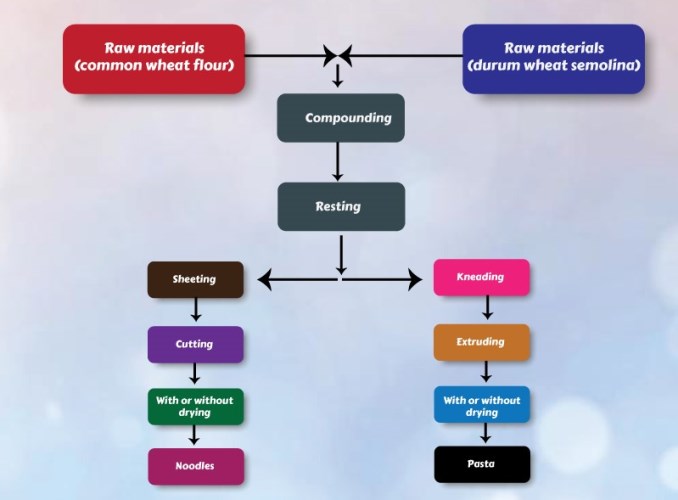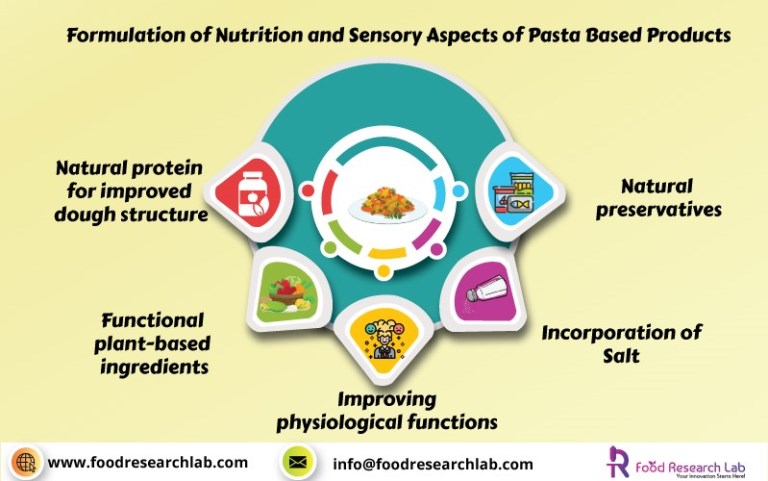
Nutritional formulation and sensory aspects of Pasta-Based Foods
Pasta based products such as noodles, spaghetti have been a staple food in many parts of the world for a very long time and one of the staple foods of the Mediterranean diet. These products continue to be popular worldwide as they are seen as a form of convenient and comfort food with enough nutritional properties. For instance, in a serving size of 100g, pasta contains 31 g of carbohydrates, 5.8 g of protein, 2 g of fiber and less than 1 g of fat. A cooked Al dente has been shown to have a low glycemic index in the range of 32-40, contributing to longer satiety.
The raw materials and exterior shaping process are different for pasta and noodles. Moreover, consumers in different regions of the world prefer different formats. Often, manufacturers add additives that are not required to the product creating a non-healthy product. Due to the rising demand for green, natural food ingredients with high effectiveness ingredients are rethought during pasta formulation and manufacturing.

Figure 1 Process flow chart for pasta manufacturing.
Natural protein for improved dough structure
Traditionally, pasta is made with simple ingredients such as the semolina of durum wheat and water. The amount of protein in the flour is of great importance for manufacturing and cooking pasta products, which also increases the nutritional quality and maintains better structure. The presence of exogenous proteins, such as Gluten (glutenin & gliadin) can improve the Farinograph properties such as chewiness of the final product. Some researchers have indicated that the addition of egg albumin or casein provides a higher resistance to breakage and cooking tolerance Moreover, casein can also reduce the uptake of oil absorption while frying. Proteins from soybean have been used for improving the pasta colour. Whey protein when added to the pasta formulation has proven to possess specific functional properties for human gastro health.
Starches
The quality of the final pasta is influence by the gelatinized starch apart from the protein network formed. Commonly, starch is added for aiding in the smoothness, mouthfeel and appearance of the end product. Either type of starches, native or modified can be used in pasta formulation, having a low gelatinized temperature and higher viscosity, providing improved quality and glossiness to the noodle or spaghetti. Starches extracted from potato, tapioca and corn starch can improve the cooking properties. Starch from mung beans has shown to produce translucent noodles. Pre gelatinization is often done to starch to improve adaptability and solubility in the manufacturing process, especially in instant and ready to eat fried noodles. Apart from that, pregelatinized starches will give better viscoelastic properties for spaghetti strings.

Functional plant-based ingredients
Functional components obtained from plant-based ingredients are used as a nutrition enhancer or to provide very specific physiological functions. U.S. Food and Drug Administration (FDA) recognize pasta as a carrier of nutrients as they are low in fat, sodium and contain no cholesterol.
- Legumes (chickpea flour, chia flour, and carob flour), cereals and egg white products could be incorporated for improving proteins and essential amino acids.
- Vegetables and germinated plant seeds can be used to improve the vitamin content. Vitamin D is used to promote the absorption of dietary calcium. Vitamin A, B6, B12, thiamin, riboflavin and folic acid are added for fortification.
- Cereal bran and seaweeds can be used for enriching the mineral concentration, like iron and calcium.
- Grain bran also improves the fiber content in pasta products.
- Fruits such as pear prickly fruit, chestnut fruit,
- Powders and extracts from plant foods and food by products such as carrot powder (10%), mango peel powder (5%), moringa leaves powder (3%), and defatted soy flour (15%) in a blend of wheat semolina and pearl millet. Mushroom powder, onion skin powder, olive paste powder, grape marc, and by products such as peelings, trimmings, stems, seeds, shells and brans
- Oil extracted from fish or vegetables can be used to improve Polyunsaturated fatty acid (PUFA) concentration.
- Cereals included in the whole grain definition are wheat (including spelt, emmer, faro, einkorn, khorasan wheat, durums), rice (including pigmented varieties), barley (including hull-less or naked barley but not pearled), corn, rye, oats (including hull-less or naked oats), millets, sorghum, teff, triticale, Canary seed, Job’s tears, fonio, black fonio and Asian millet. Maize blue, red and purple varieties are used in pasta making.
- In the Journal of the Science of the Food and Agriculture demonstrated that Spirulina could be added to pasta without microencapsulation. However, the microencapsulation procedure allows the protection of the antioxidant potential of the biomass, representing a potential alternative for the bakery industry.
- Pseudo cereals included in the whole grain definition are amaranth, buckwheat and tartar buckwheat, quinoa, and wild rice. Substituting dried amaranth leaves as semolina substitutes in the preparation of elbow-type pasta.
Improving physiological functions
Flours such as chickpea, soybean and flax seeds have been shown to reduce the hyperglycemic phase of the supplemented pasta, which results in a low glycemic index of the products. This aids in the reduction of body weight, hyperinsulinemia and hyperlipidemia. Fibers (soluble and insoluble) when incorporated into pasta and noodle-based products, digestion and absorption in the intestine are improved. Frequently used fibers are from a legume, wheat bran, psyllium husk and olive powder. A few of the non-starch polysaccharides used are locust bean gum, guar and xanthan gum. Studies have shown that bamboo fiber has also been used as an ingredient in pasta production, which improves the final texture of the product. Banana flour and edible canna starch have been shown to increase the RS levels and are a source of antioxidant polyphenols in noodle and pasta-based products. Quinoa, buckwheat and amaranth are used for making gluten free pasta and noodles containing high protein and functional components. Pigeon pea starch when blended with rice starch showcased superior quality noodles with improved smoothness, transparency and overall acceptability.
Special ingredients are incorporated for their antioxidant and anticancer properties. For instance, naturally extracted anthocyanin, carotenoids, betalin have gained focus as they enhance functional, nutritional and sensory qualities. Pasta incorporated with 10 % wakame was shown to have antioxidant properties, total phenolic content, fatty acid composition and better acceptability in the final product.
Specific conditions
Celiac Patients: According to the study published in the Journal of Cereal Science, in the year 2021, the presence of buckwheat flour in the formulation (49.2–99.4%) resulted in an experimental pasta with a high protein and dietary fiber content (values ranging from 8.9 to 11.2% d.w., and 8.9–14.4% d.w, respectively), hence making the innovative products suitable for celiac patients.
Enzymes:
Biocatalyst or commonly called enzymes are derived from microorganisms, plants and even animal tissues. The incorporation of enzymes in wheat-based pasta and noodles have proven to show improved possibilities. Glucose oxidase, peroxidase, galactose oxidase and lipoxygenase are used instead of chemical oxidants in wheat flour. Lipoxygenase from soybean inhibits discoloration in white noodles. Durum wheat flour, which is low in lipoxygenase is used for pasta production.
Edible gums:
Similar to dietary fibers, edible gums are also used in the production of pasta based products, to provide the structure for dough and a palatable mouth feel. Gums such as guar, xanthan, locust bean effect on the tenacity of the protein starch matrix and thus affect the eating qualities of the Food product. These gums also act as a gluten enhancer making the dough much stronger. Edible guns are also used essentially in gluten-free pasta and noodle preparation to balance and counteract the poor technological properties.
Incorporation of Salt:
In pasta manufacturing, two distinct categories can be made based on the presence of table salt or alkaline components. The addition of table salt enhances the formed network of pasta dough and provides a mouthfeel to the products. Salt also helps in preserving the dough. On the other hand, alkali salts such as sodium carbonate (Na2CO3) and potassium carbonate (K2CO3) are used mainly for extending the shelf life and providing an impact on flavour and the final texture of the noodles.
Natural preservatives:
Due to the high water content and nutrient concentration, pasta and noodles have a short shelf life and will deteriorate quickly if not stored properly. Researchers have identified potential natural antimicrobials which can be used in specific applications.
- Organic acids such as lactic, sorbic, malic and citric acid can be used in juices, jam and fresh noodles.
- Natural alcohols such as sorbitol, glycerol and ethanol can be used in steamed bread and fresh noodles.
- Essential oils such as menthol, thymol and eugenol can be used in fresh pasta and bread.
- Herbs, spices and tea extracts can be used in noodles, juices and bread.
- Chitosan, basic proteins, peptides and Maillard reaction products can be used in noodles, meat, dairy and bread.

References
- Demir, B., & Bilgiçli, N. (2021). Utilization of quinoa flour (Chenopodium quinoa Willd.) in gluten-free pasta formulation: Effects on nutritional and sensory properties. Food Science and Technology International, 27(3), 242-250.
- Nocente, F., Natale, C., Galassi, E., Taddei, F., & Gazza, L. (2021). Using einkorn and tritordeum brewers’ spent grain to increase the nutritional potential of durum wheat pasta. Foods, 10(3), 502.
- Palavecino, P. M., Curti, M. I., Bustos, M. C., Penci, M. C., & Ribotta, P. D. (2020). Sorghum Pasta and Noodles: Technological and Nutritional Aspects. Plant Foods for Human Nutrition, 75, 326-336.
- Llavata, B., Albors, A., & Martin-Esparza, M. E. (2020). High fibre gluten-free fresh pasta with tiger nut, chickpea and fenugreek: Technofunctional, sensory and nutritional properties. Foods, 9(1), 11.





